How award winners deploy social media
By Robert Bergland
Northwest Missouri State University
 Abstract: The Internet and social media have transformed all college media outlets, and the yearbook is no exception. But, while there have been some studies on the impact of these technologies on commercial and college newspapers, yearbooks have not received such scrutiny. This study of award-winning yearbooks attempts to shed light on how yearbooks are using social media to promote their events, their staffs and their content. Using the 22 yearbooks that have been named a finalist in the major competitions in the last three years, this paper examines the number of followers, the number of posts, the content of these posts and the follower response to those posts during the fall 2018 semester.
Abstract: The Internet and social media have transformed all college media outlets, and the yearbook is no exception. But, while there have been some studies on the impact of these technologies on commercial and college newspapers, yearbooks have not received such scrutiny. This study of award-winning yearbooks attempts to shed light on how yearbooks are using social media to promote their events, their staffs and their content. Using the 22 yearbooks that have been named a finalist in the major competitions in the last three years, this paper examines the number of followers, the number of posts, the content of these posts and the follower response to those posts during the fall 2018 semester.
Introduction: College yearbooks are in a time of transition. On one hand, in an age of the internet and social media, the print-centric traditional yearbook is in danger of becoming a relic of the past. The cost of producing the yearbook, the ability to provide its content digitally and the digital-native demographic of most of the yearbooks’ authors and readers has threatened the very existence of the print college yearbook. Not surprisingly, many colleges have chosen to move to an electronic-only version of a yearbook, to change the format to a magazine produced more often or to eliminate the yearbook altogether. On the other hand, the ephemeral nature of digital-only outlets on the Web (Myspace, anyone?) and the obsolescence of various “hard” electronic distribution methods (CDs, once touted as a replacement or supplement for yearbooks, are no longer able to be read on most computers today) make the permanence of the print yearbook attractive. Given that yearbooks are meant to be mementos, physical keepsakes and historical records that many graduates keep their entire lives, there is a strong argument for maintaining the yearbook in print, in a form that will be guaranteed to be easily accessible and readable in 10, 50 or 100 years.
Regardless of whether the college yearbook is in print or digital form, one thing is clear: college yearbook staffs should be using digital technologies—and especially social media—for the benefit of current readers, future readers and themselves. From a promotional standpoint, not utilizing the available technologies to encourage book sales (for those yearbooks who sell the book) and pickup (for those yearbooks who rely on student fees to produce the book for all students) translates into fewer people reading the book. An indifferent or Luddite approach to the new platforms diminishes the hard work of the staff by limiting the number of people who end up with the book in their hands. Not promoting portrait or organization photos likewise decreases the amount of student participation in the book’s content, detracting from the comprehensiveness of the book and the likelihood of students purchasing/picking up the book.
Yearbooks can also use social media as a means for connecting not only with current potential readers, but also with past readers. Through updates about campus events, links to new or past stories or the sharing of current or past spreads or covers, yearbook staffs can provide information to alumni and other non-student university stakeholders. Indeed, while yearbook content is often less timely and more feature-oriented than campus newspaper content, in many ways the technologies have blurred the lines between newspapers and yearbooks. While yearbooks might not use their webpages as much as newspapers for distributing news, they can use social media to provide information and content to current students, past students and the campus and surrounding communities.
From an educational perspective, perhaps the most important benefit of yearbooks’ use of social media is preparing the staff for careers in journalistic and related fields. For better or worse, social media and the Web are integral parts of the publishing world. Whether the students go on to careers in journalism, public relations, book publishing, photography, graphic design or business/technical writing, their experience with those technologies is critical in preparing them for jobs in those areas. Just as their experience with writing, editing and design is important in their educational development, so too should they be using and gaining experience in social media to help them learn about the field.
The question, of course, is how college newspaper staffs can and should be using social media. One answer to that question begins with looking at the best ways that some college yearbooks are already using the technologies. To that end, our goal was to study some of the best yearbooks and to analyze their social media activity. What platforms are they using the most? How often are they posting? What things are they posting about? How much and in what ways are readers interacting with the yearbooks on social media?
In trying to answer those questions, we chose the best print yearbooks in the country, the ones who had been named a finalist in the past three years in the general excellence category in a major national competition (There are no award categories for yearbook-only websites or social media presence, so we were left to look at the best yearbooks overall. As with college newspapers, an outstanding print version sometimes—but definitely not always—transfers over into a quality digital product). In the end, we examined 22 yearbooks, studying their use of Facebook and Twitter (the most commonly used social media platforms) over the course of a full semester, fall 2018.
A Shortage of College Newspaper and Yearbook Research on Social Media
Literature Review: Let’s begin by being blunt: there is a dearth of scholarship on college yearbooks. To the best of our knowledge, no one has published a yearbook-only research article in a scholarly journal. An examination of the indices of numerous journals that have included studies on college newspapers comes up empty for college yearbooks. A Google Scholar search of college yearbooks yields psychological studies about smiling and appearance in yearbook portrait photos, but no empirical research about the yearbooks themselves.
Even College Media Review, the most friendly home for any such research, has been largely devoid of any articles devoted to yearbooks, let alone scholarly investigations of them. There have been no studies in any of the CMR Research Annuals, and a search using the term “yearbook” on the CMR website for the last decade brings up only two yearbook-only articles, both published by Susan Smith in 2013. The first, “The Future of the Venerable Yearbook,” is a well-done, thorough journalistic article (not a quantitative or qualitative study) with interviews of yearbook advisers and people in the industry, while an accompanying piece in the same issue, “South Dakota State University Students Resurrect Yearbook” is a narrative of her school’s decision to bring back its annual. Other research and non-research articles bring up yearbooks only tangentially, as a small part of a look at entire media program offerings. We hope this article begins a new research emphasis on college yearbooks.
There have been a few studies that have looked at college newspapers and how they have used the web and social media. Brockman, Bergland & Hon (2011) examined online Pacemaker winner websites, focusing on multimedia, interactive and distribution features used by those top publications. A 2013 AEJMC paper, “Content Management Systems, Distribution and Social Media on College Newspaper Websites” was more recent and exhaustive, examining 392 college newspapers, one-fourth of the nearly 1,600 college newspapers in the Editor and Publisher directory. Amazingly, over a third (36%) of those publications didn’t even have a website, almost the exact same percentage as a 2008 study. Of those that did have a website, 31% had a Twitter badge/link on their website, with 18% including their Twitter feed on their website. About the same amount had a Facebook badge/link (35% of those with a website, 21% of all the publications, including those without a website), while 9% of those college newspapers had their Facebook feed on their website.
Commercial Newspaper Use of Social Media
While there has been no study of how exactly college newspapers are using social media—we intend to follow up this study with a related one on college newspapers in the next year—there has been ample research about how commercial newspapers in the United States and around the world are using social media. Facebook studies have included pieces such as Welbers and Obgenhaffen (2019), which found that newspaper Facebook posts in Dutch and Flemish newspapers were often more personal and subjective than the headlines and leads of stories in the newspaper. Genc (2019) analyzed how Turkish journalists are using Facebook and Twitter to distribute the news. In a country where 900 newspapers have closed in the last five years and only 1,000 still exist, readers are turning to social media first for their news, and journalists are accommodating that preference. Other articles focus on how newspapers use social media to cover special events, such as earthquakes (Volterrania, Iezzia & Cecchere 2018) and elections (Skogerbo & Krumsvik 2015).
Another area of social media research is how journalists use social media for sources. Paulussen & Harder (2014) examined Flemish newspapers to find the many instances of when Twitter, Facebook or YouTube were cited as a source by journalists. Broersma & Graham (2013) did a similar study of Dutch and British papers, looking for citations using Twitter, as did Moon and Hadley (2014) in their study. Nordheim, Bozcek & Koppers (2018) did one of the most comprehensive studies of social media use as a source, looking at the New York Times’social media sources over a 10-year period.
Some of the more valuable studies, as they relate to this research, are the ones which analyze how the newspapers and journalists are taking advantage of the capabilities and potential of Facebook, Twitter or both. In a relatively early study, Armstrong and Gao (2010) looked at news organizations’ use of Twitter, finding that they most often tweeted about crime and public affairs issues. Ju, Jeong & Chyi (2014), in their seminal study, “Will Social Media Save Newspapers?” also study Twitter and Facebook from an organizational perspective. Their 2012 examination of 66 U.S. newspapers answered the question in the title with a “no,” that while social media drove more traffic to the newspapers’ websites, the gain in revenue was “underwhelming.” For their newspapers studied in 2012, Twitter reached a bigger audience than Facebook for distributing news content.
Other studies have focused not on the journalistic organizations, but on how journalists themselves are using social media. Lasorsa, Lewis & Holton (2012) note in their analysis of 22,000 Tweets by journalists that many journalists shed some of their objectivity in their tweets, including more opinion, more of their personal lives and more transparency about the newsgathering process. Parmlee (2013) looked at political journalists in the 2012 election, finding that Twitter especially, more so than Facebook, has changed how political journalists operate—and not necessarily always in a good way, as the pressure to tweet sometimes affects the actual writing of news stories. Engesser & Humprecht (2015) took a broader approach, looking not only at journalists across fields, but across continents, examining 39 social media accounts of journalists in five Western countries. Again, Twitter reigned supreme, but most of the users were not taking full advantage of the capabilities of Twitter or its ability to connect with readers.
Still other studies have looked at social media and newspapers from the perspective of the user. Larssen (2018) studied the readers of Norwegian newspapers, looking at the levels of interaction with Facebook and Instagram. Another study involving Larsson and co-author Kalsnes (2018) focuses on sharing on Facebook, concluding that users most often share content that is celebrity-focused, sensational or other soft news.
Research Questions: Based on our examination of the literature and a sample examination of numerous yearbook social media feeds, we came up with several research questions.
RQ1 What percent of the yearbooks are active on Twitter and Facebook?
RQ2: What are the most common subjects of social media posts?
-
-
- Is there a difference between what they post on the different social media platforms (ex: do they post differently on Twitter vs what they post on Facebook?)
-
RQ3: How often do yearbooks post to social media?
-
-
- How much difference is there in their number of FB v Twitter posts?
- Is there a correlation between the enrollment and number of followers and how often they post?
- Is there a correlation between how decorated the yearbook is and how often they post (do multiple-award winning books post more often?)
-
RQ4: How many followers does each yearbook have on each platform?
-
-
- Is there a correlation between the number of followers and the enrollment?
- Is there a significant difference between the number of followers on each platform?
-
Methodology
Subject selection: One of the problems in doing a study of college yearbooks (and perhaps one reason why there is a lack of scholarship on college yearbooks) is there is no reliable, current and exhaustive directory of college yearbooks. While there are a few college newspaper directories—most notably, the Editor and Publisher compilation of approximately 1,600 college newspapers—there is no directory for yearbooks, making any full-blown study of all college yearbooks difficult at best. So, one of the key questions for our study was how to settle on a list of yearbooks to study. It was important to not have a haphazard collection, but one that was selected in a logical manner, hopefully using a process employed in previous studies. In addition, the goal in selecting the books to study was not to create an overview of what all yearbooks were doing, but an example of what the best yearbooks were doing to provide a model for what yearbooks could and should be taking advantage of in social media outlets.
To that end, we chose to use a methodology employed in previous newspaper studies published in College Media Review. In a 2011 study of college newspapers, Brockman, Bergland and Hon were also looking to use the best newspapers as an example of what interactive, multimedia and distribution features should be included on campus newspaper websites. In doing so, they chose to pick the winners of three years’ worth of Associated Collegiate Press Pacemaker competitions. More recently, Terracina-Hartman and Nulph (2016) used a similar technique when examining how colleges were promoting the success of their newspapers. They used a more robust method, not only using Pacemakers, but also the Columbia Scholastic Press Association Gold Crown winners and the College Media Association Pinnacle winners. Using a weighted system giving points for the various award levels (first/second/third/honorable mention), they took the top 35 newspapers to work with.
This study likewise used a list of the finalists and award winners for the ACP Pacemakers, the CSPA Gold Crown Awards and the CMA Pinnacles for a period of three years: 2016, 2017 and 2018. All yearbooks that earned at least one general excellence recognition (finalist or award winner) in the last three years were included in the study. Twenty-three yearbooks met that standard. One yearbook, the Western Kentucky Talisman, had converted to a magazine recently and was eliminated from the study, because of its new focus and because its frequency and content of posts were remarkably different than the other yearbooks (Its conversion and use of social media is worthy of a completely separate qualitative study).
Social media outlets: In our initial examination of several of the award-winning yearbooks, we noticed that they were predominately using Twitter or Facebook, or in some cases, both. As far as the other main social media outlets, only a few were using Instagram, and for the most part, their Instagram posts mirrored their Facebook posts (not surprising, since Facebook owns Instagram and has built-in capability to cross-post). Pinterest, while a seemingly conducive platform for yearbooks, was not really used at all, most likely because the college demographic by and large does not use Pinterest nearly as much as their parents (or grandparents, for that matter). As a result, we chose to focus our data collection on Facebook and Twitter.
Collection period: The original plan was to collect data on Facebook and Twitter posts for a month. However, an initial pilot study of some yearbooks’ social media postings revealed that many of the staff members weren’t posting much and that a full semester would be necessary to have adequate data to work with. In addition, there was the concern that using only a month of posts might skew the data, as the post content was very much tied to the time in the yearbooks’ season. For example, the month of September for many books is a time of yearbook presales or pickup, while October is a time of pushing portraits. So, we decided to use a full semester, choosing the most recent full semester, fall 2018. We defined that period as Aug. 15 to Dec. 31 to encompass the full traditional semester.
Taxonomy/Data Coding: A key focus of the study was to find out what yearbooks were posting about. Was it focused on yearbook content being produced? The organization/staff? Promoting the book or encouraging people to get their portraits taken? To get answers to those questions, a taxonomy was created after reviewing the feeds of several yearbooks. After an initial pilot study of a yearbook (not on the list of award winners) that posted frequently the taxonomy was revised, collapsing a few categories and adding others.
Followers/Posts: In addition to coding the Tweets and Facebook posts, other information was also collected:
-
- total number of posts
- number of followers
- number of reactions to posts (splitting them up into likes and comments)
- number of posts that were text only, had graphics/photos or had video
Results
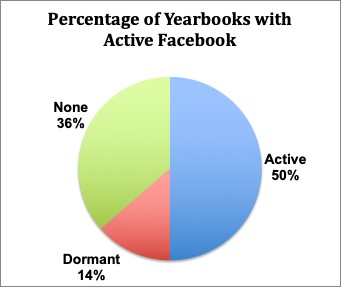
Social Media Presence: The first research question addressed whether the yearbooks were even using Facebook and Twitter. Surprisingly, only half of the yearbooks were using Facebook actively in the fall of 2018 (Chart 1). Eleven were using Facebook, three had dormant accounts and eight had no Facebook page whatsoever.
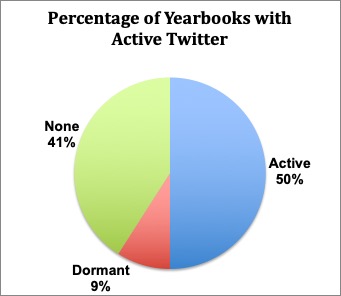
The same was true of Facebook. Half the yearbooks did not have a Twitter account (Chart 2). Interestingly, though, some of the yearbooks that did not have a Facebook page did have a Twitter account. Neither the Indiana Arbutus and the Troy Palladium had a Facebook page, but they both had a Twitter page, and two of the most active Twitter pages at that. One yearbook, the Harding Petit Jean did not have its own Twitter page, so is counted as not having a separate yearbook Twitter account, but it did combine with other student media for a Harding Pubs account. However, virtually all of the posts that semester were generated by the newspaper.
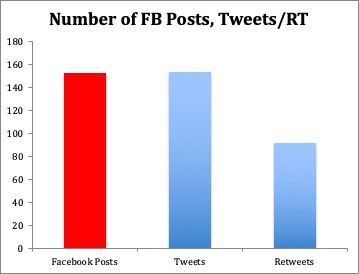
Activity: One of the other key questions was how often the yearbooks were posting (Chart 3). Amazingly, the number of Facebook posts (152) was almost identical to the amount of original tweets (153).
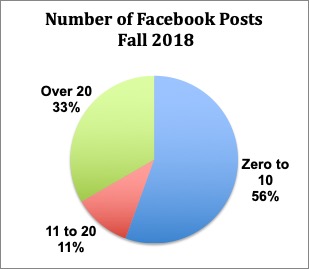
Within that number, though, there was a significant difference in the amount of posting (Chart 4). Nearly half of the yearbooks (5 of the 11) posted six or fewer times to Facebook over the course of the semester, or about one or two times a month. On the high end of the spectrum, Virginia Tech, which has no Twitter page, posted 33 times, or seven to eight times a month on average. It should be noted, however, that the posting frequency did not fit into a neat “average.” Getting into the weeds of the data, one can find a common, unsurprising occurrence: a staff may start the semester posting like gangbusters, and come the end of October, post little or nothing the rest of the semester.
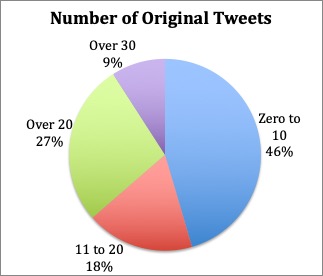
The number of Tweets was likewise very disparate (Chart 5). On one end of the spectrum, the Indiana Arbutus—which had no Facebook page—tweeted 65 times, while again, nearly half of the schools with a Twitter presence tweeted fewer than 10 times over the course of the fall 2018 semester.
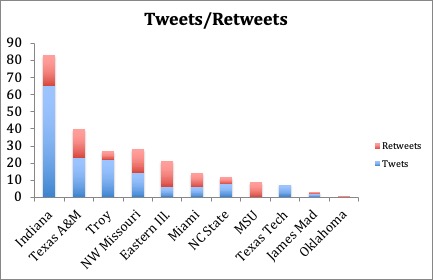
The following graph (Chart 6) better shows the discrepancy between schools and also adds in the number and percent of retweets. As can be seen in the graph, some schools don’t retweet at all or very little, while other schools only retweet or retweet more than they tweet.
As shown above, Indiana’s tweeting far outpaced that of the other schools, comprising 42% of the total number of tweets by the award-winning books.
Types of social media posts: One of the most important questions for the study addressed the actual content of the posts. The hypothesis, based on the literature review and personal experience with newspaper use of social media, was that the majority of the posts would be promoting content, with links to stories. With these yearbooks, however, that was far from the case. Instead, almost half of the Facebook posts were either promoting the buying or picking up of the yearbook or encouraging people to have their portraits or their organizational photos taken/submitted. (Chart 7).
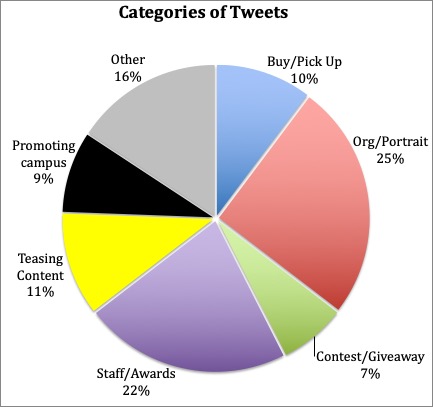
The tweets were remarkably similar: the vast majority promote the book or the staff in some way, with about half of those again coming in the sales/pickup of the book or the push to have individual or organizational photos taken. Interestingly, though, while only a couple Facebook posts teased content the staffers were working on, 14 tweets (almost 10%) teased content, with a few tweets that provided web links to stories. (Chart 8).
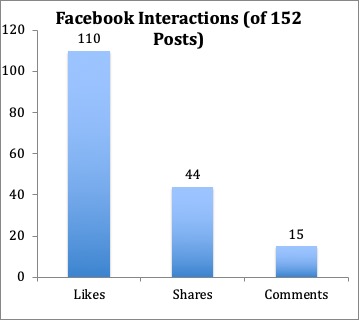
Follower Response: Lacking the access for detailed analytics for each of the yearbooks’ Facebook and Twitter pages, we were left with the more rudimentary Like and Share/Retweet metrics for judging the response of the readers. For Facebook, that amounted to 110 of the 152 posts being liked (72%), although it should be noted that 89 of those posts had five or fewer Likes. Less than a third of the posts were shared, and only 10% generated any comments. (Chart 9)

The Twitter likes again were remarkably similar, with about 75% of the tweets getting liked (again, most of them just getting a few likes), although a greater percentage were retweeted. There were only two comments on all of the tweets. (Chart 10).
The reach and response rate can also be affected by an effective use of the hashtag and @ in tweets. Many schools never used either in their tweets; the bulk of the ones used were from just a couple of the yearbooks.
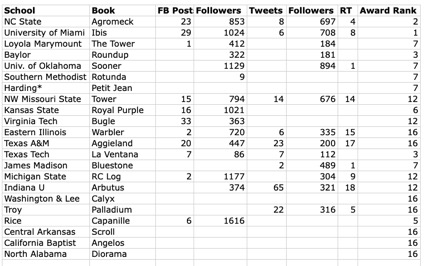 Correlation between enrollment and number of awards and social media presence: The simple hypothesis for the impact of enrollment was this: The bigger the school, the bigger the book, budget and staff will likely be, and thus the greater likelihood that there may be a staff member dedicated to social media and a bigger audience to serve. To a large part, that was true. The schools without any social media presence (Washington & Lee, Harding, Central Arkansas, North Alabama and California Baptist), are all among the smallest universities on the list. The latter three universities also have another thing in common—they received only one finalist award over the past three years. On the other end of the spectrum, the most-awarded yearbooks were among the most active on social media. The University of Miami Ibis and North Carolina State Argomeck, the two books winning the most general excellence awards the last three years in CSPA/CMA/ACP competitions, were also two of the most active on social media. It should be noted, though, that there were definitely exceptions to the correlation between the size of the school and number of awards won and the amount of social media presence. For example, Baylor, one of the biggest and most decorated schools, had no social media presence. Northwest Missouri State, with fewer awards and an enrollment under 10,000, was among the more active on both Facebook and Twitter. (Chart 11).
Correlation between enrollment and number of awards and social media presence: The simple hypothesis for the impact of enrollment was this: The bigger the school, the bigger the book, budget and staff will likely be, and thus the greater likelihood that there may be a staff member dedicated to social media and a bigger audience to serve. To a large part, that was true. The schools without any social media presence (Washington & Lee, Harding, Central Arkansas, North Alabama and California Baptist), are all among the smallest universities on the list. The latter three universities also have another thing in common—they received only one finalist award over the past three years. On the other end of the spectrum, the most-awarded yearbooks were among the most active on social media. The University of Miami Ibis and North Carolina State Argomeck, the two books winning the most general excellence awards the last three years in CSPA/CMA/ACP competitions, were also two of the most active on social media. It should be noted, though, that there were definitely exceptions to the correlation between the size of the school and number of awards won and the amount of social media presence. For example, Baylor, one of the biggest and most decorated schools, had no social media presence. Northwest Missouri State, with fewer awards and an enrollment under 10,000, was among the more active on both Facebook and Twitter. (Chart 11).
Instagram: The use of Instagram, arguably the best social media platform for the visually centric yearbook, largely paralleled the other social media use of yearbooks. Similar to Facebook and Twitter, roughly half (12) had active, dedicated Instagram accounts. When accounting for the two schools that had combined student media accounts (the yearbook sharing an account with the newspaper and other media) and one school with a dormant account, 15 of the 22 books had some sort of Instagram presence. For the 12 active dedicated accounts, they had an average of 545 followers, with a high of 885 (Troy) and a low of 248 (Texas Tech). The average number of posts for the fall semester was 16, with a high of 32 posts (Virginia Tech) and a low of 2 (Miami). In short, the number of posts on Instagram was roughly similar to the number of Facebook and Instagram posts, although the number of followers was generally smaller on Instagram. However, it is interesting to note that the yearbooks’ use of Instagram was not necessarily consistent with their usage of Facebook and Twitter. For example, some of the schools that were active on both Facebook and Twitter had no Instagram presence whatsoever (Eastern Illinois and Northwest). Conversely, other schools that didn’t post at all during fall 2018 on Facebook and Twitter did have an active Instagram account (Baylor, Central Arkansas). In all, out of the 22 top yearbooks in the country, only four had active, dedicated accounts on the three main social media platforms of Facebook, Twitter and Instagram: Texas Tech, Texas A&M, Miami and North Carolina State.
Conclusions: One of the most surprising findings from the study was sheer lack of social media engagement on the two major platforms. To be frank, it was disheartening to see only half of the yearbooks make even a solitary post on Facebook. Likewise, only half tweeted, and several of those schools who did tweet only tweeted a couple times or largely just retweeted from university or other sources. It’s especially important to remember: these are the very best books in the country. True, there is not necessarily a direct, causal link between what these publications are doing in print vs what they are doing online, just as the best print newspapers may not be the best newspapers online. Still, if half of the biggest, best and quite likely the best-funded yearbooks are not using Facebook or Twitter, one has to wonder what that percent is at all of the smaller schools with smaller books, smaller staffs, smaller budgets and lower quality. It’s logical to assume that an even higher percentage are not taking advantage of the technology to help recruit staff and promote the book.
The other less surprising finding was how little social media was used to actually promote the content of the book. For many staffs, about the only types of post were (multiple) reminders to the campus community about book sales/pickup or portraits/organizational photos. While those are surely the most important things to yearbooks and their bottom lines, the actual content of the book could have also been used help drive interest in the book. There were only a handful of examples of posts with spreads, stories and covers to help people appreciate the quality of the books (for that matter, there were surprisingly few social media posts about the awards that these books won).
The number of followers vs the size of the school and social media activity as seen in the chart above has some huge discrepancies. The Texas Tech yearbook, for example, has only 86 Facebook followers, about a tenth of the number of a Northwest Missouri State—all the more remarkable considering Texas Tech has about five times the enrollment. Clearly, a staff in that position needs to work on increasing that number of followers to make its posts more effective. By the same token, some schools with a great number of followers are squandering their opportunity by not taking advantage of that following. The Sooner, with 1,129 Facebook followers, didn’t post at all in the fall of 2018. Rice, topping the list with 1,616 followers, only posted six times.
Based on the findings in this study, there are several things the student media field might wish to consider:
-
- More sessions at state and national conferences dedicated to yearbook use of social media, outlining ways to more effectively take advantage of the main platforms.
- More training materials—perhaps in the form of resources available on the CMA website—such as tips for increasing the number of followers, job descriptions for social media editors and strategies for promoting the book and content on social media.
- More research studies and practical articles on social media in College Media Review, College Media Matters and other outlets.
- Perhaps a new contest category for semester- or year-long social media campaigns for yearbooks.
Limitations and Future Studies: The biggest limitation of this study is, of course, the small number of books examined. While the goal of the study was to provide an example, a model of what the best print books are doing, the selection method and small number of books examined mean that the results here cannot be generalized to the yearbook population in general. With a more expansive list—perhaps using the CMA directory, singling out yearbook advisers—a fuller snapshot of what more books are doing would be possible. Another limitation is the restriction to just Facebook and Twitter. A future study could also examine Instagram in greater detail, as there were a few yearbooks that were using that platform extensively and effectively.
Finally, this study only looks at the external, final product of the social media posts. Ideally, a follow-up study would use other research methods to triangulate the data. A survey of these (and other) yearbooks about their social media plans and setup (for example, which staffers/editors are posting? How many different people are posting? Do they have any training or guidelines for what they post?) would add different insights. In addition, interviews with advisers and EICs would yield perhaps the most useful data about what has been done in the past, why they post the way they do, whether they have a dedicated social media editor and what their plans are in the future.
Works Cited
- Armstrong, C. L., & Gao, F. (2010). Now Tweet this: How news organizations use Twitter. Electronic News,4(4), 218-235. doi:10.1177/1931243110389457
- Bergland, R., Hon, D. Noe, S. & Hartigan, K. (2008). Interactivity and multimedia on college newspaper websites. Paper presented at National College Media Convention, Kansas City, MO. Nov. 1.
- Brockman, C., Bergland, B., & Hon, D. (2011). Research spotlight: Top student news Web sites share multimedia, interactive features. College Media Review, 49 (1).
- Broersma, M., & Graham, T. (2013). Twitter as a news source. Journalism Practice,7(4), 446-464. doi:10.1080/17512786.2013.802481
- Engesser, S., & Humprecht, E. (2014). Frequency or skillfulness. Journalism Studies,16(4), 513-529. doi:10.1080/1461670x.2014.939849
- Ju, A., Jeong, S. H., & Chyi, H. I. (2013). Will social media save newspapers? Journalism Practice,8(1), 1-17. doi:10.1080/17512786.2013.794022
- Kalsnes, B., & Larsson, A. O. (2017). Understanding news sharing across social media. Journalism Studies,19(11), 1669-1688. doi:10.1080/1461670x.2017.1297686
- Larsson, A. O. (2017). The news user on social media. Journalism Studies,19(15), 2225-2242. doi:10.1080/1461670x.2017.1332957
- Lasorsa, D. L., Lewis, S. C., & Holton, A. E. (2012). Normalizing Twitter. Journalism Studies,13(1), 19-36. doi:10.1080/1461670x.2011.571825
- Nordheim, G. V., Boczek, K., & Koppers, L. (2018). Sourcing the sources. Digital Journalism,6(7), 807-828. doi:10.1080/21670811.2018.1490658
- Parmelee, J. H. (2013). Political journalists and Twitter: Influences on norms and practices. Journal of Media Practice,14(4), 291-305. doi:10.1386/jmpr.14.4.291_1
- Paulussen, S., & Harder, R. A. (2014). Social media references in newspapers. Journalism Practice,8(5), 542-551. doi:10.1080/17512786.2014.894327
- Skogerbø, E., & Krumsvik, A. H. (2014). Newspapers, Facebook and Twitter. Journalism Practice,9(3), 350-366. doi:10.1080/17512786.2014.950471
- Smith, S. (2013). The Future of the venerable yearbook. College Media Review 50 (4).
- Smith, S. (2013). South Dakota students resurrect yearbook. College Media Review 50 (4).
- Terracina-Hartman, C., & Nulph, R. (2016). Measuring the visibility of college media at “Home.” College Media Review53.
- Volterrania, A., Iezzia, D. F., & Alessio Cecchere, A. (2018). Communication of a natural disaster. An earthquake case in social media and online newspapers. Sociology Study 8(6) 257‐266 doi: 10.17265/2159‐5526/2018.06.001
- Welbers, K., & Opgenhaffen, M. (2018). Presenting news on social media. Digital Journalism,7(1), 45-62. doi:10.1080/21670811.2018.1493939
 Bob Bergland teaches introductory and advanced journalism classes at Northwest Missouri State University. In addition to being a newspaper and magazine journalist, he’s been a newspaper adviser, Fulbright teacher in Ukraine and has led students on multiple study abroad trips to Europe. He co-leads the Cronkite New Voices bill effort in Missouri.
Bob Bergland teaches introductory and advanced journalism classes at Northwest Missouri State University. In addition to being a newspaper and magazine journalist, he’s been a newspaper adviser, Fulbright teacher in Ukraine and has led students on multiple study abroad trips to Europe. He co-leads the Cronkite New Voices bill effort in Missouri.
